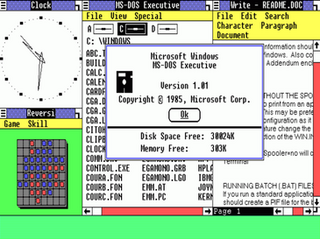Related Research Articles

Digital Equipment Corporation, using the trademark Digital, was a major American company in the computer industry from the 1960s to the 1990s. The company was co-founded by Ken Olsen and Harlan Anderson in 1957. Olsen was president until he was forced to resign in 1992, after the company had gone into precipitous decline.

Alpha is a 64-bit reduced instruction set computer (RISC) instruction set architecture (ISA) developed by Digital Equipment Corporation (DEC). Alpha was designed to replace 32-bit VAX complex instruction set computers (CISC) and to be a highly competitive RISC processor for Unix workstations and similar markets.

Lotus 1-2-3 is a discontinued spreadsheet program from Lotus Software. It was the first killer application of the IBM PC, was hugely popular in the 1980s, and significantly contributed to the success of IBM PC-compatibles in the business market.
Symbolics, Inc., was a privately held American computer manufacturer that acquired the assets of the former company and continues to sell and maintain the Open Genera Lisp system and the Macsyma computer algebra system.

VisiCalc is the first spreadsheet computer program for personal computers, originally released for the Apple II by VisiCorp on October 17, 1979. It is considered the killer application for the Apple II, turning the microcomputer from a hobby for computer enthusiasts into a serious business tool, and then prompting IBM to introduce the IBM PC two years later. More than 700,000 copies were sold in six years, and up to 1 million copies over its history.

An embedded system is a computer system—a combination of a computer processor, computer memory, and input/output peripheral devices—that has a dedicated function within a larger mechanical or electronic system. It is embedded as part of a complete device often including electrical or electronic hardware and mechanical parts. Because an embedded system typically controls physical operations of the machine that it is embedded within, it often has real-time computing constraints. Embedded systems control many devices in common use. In 2009, it was estimated that ninety-eight percent of all microprocessors manufactured were used in embedded systems.

GNU Octave is a scientific programming language for scientific computing and numerical computation. Octave helps in solving linear and nonlinear problems numerically, and for performing other numerical experiments using a language that is mostly compatible with MATLAB. It may also be used as a batch-oriented language. As part of the GNU Project, it is free software under the terms of the GNU General Public License.
Lotus Software was an American software company based in Massachusetts; it was sold to India's HCL Technologies in 2018.

In computer architecture, 64-bit integers, memory addresses, or other data units are those that are 64 bits wide. Also, 64-bit central processing units (CPU) and arithmetic logic units (ALU) are those that are based on processor registers, address buses, or data buses of that size. A computer that uses such a processor is a 64-bit computer.
MultiFinder is an extension for the Apple Macintosh's classic Mac OS, introduced on August 11, 1987 and included with System Software 5. It adds cooperative multitasking of several applications at once – a great improvement over the previous Macintosh systems, which can only run one application at a time. With the advent of System 7, MultiFinder became a standard integrated part of the operating system and remained so until the introduction of Mac OS X.

The Tandy 2000 is a personal computer introduced by Radio Shack in September 1983 based on the 8 MHz Intel 80186 microprocessor running MS-DOS. By comparison, the IBM PC XT used the older 4.77 MHz Intel 8088 processor, and the IBM PC/AT would later use the newer 6 MHz Intel 80286. Due to the 16-bit data bus and more efficient instruction decoding of the 80186, the Tandy 2000 ran significantly faster than other PC compatibles, and slightly faster than the PC AT. The Tandy 2000 was the company's first computer built around an Intel x86 series microprocessor; previous models used the Zilog Z80 and Motorola 6809 CPUs.
A memory debugger is a debugger for finding software memory problems such as memory leaks and buffer overflows. These are due to bugs related to the allocation and deallocation of dynamic memory. Programs written in languages that have garbage collection, such as managed code, might also need memory debuggers, e.g. for memory leaks due to "living" references in collections.

The Amstrad PC1512 was Amstrad's mostly IBM PC-compatible computer system, launched in 1986, and advertised with prices from £399 plus VAT. The system was also marketed in the US by Texas-based Vidco Inc. from the start of 1987. Later in 1987, a slightly updated version called the PC1640 was introduced, also marketed as the PC6400 and Sinclair PC500. Schneider branded machines for the German market were also sold.

Simulink is a MATLAB-based graphical programming environment for modeling, simulating and analyzing multidomain dynamical systems. Its primary interface is a graphical block diagramming tool and a customizable set of block libraries. It offers tight integration with the rest of the MATLAB environment and can either drive MATLAB or be scripted from it. Simulink is widely used in automatic control and digital signal processing for multidomain simulation and model-based design.

Small form factor is a term used for desktop computers and for some of their components, chassis and motherboard, to indicate that they are designed in accordance with one of several standardized form factors intended to minimize the volume and footprint of a desktop computer compared to the standard ATX form factor.

Windows 1.0 was the first major release of Microsoft Windows, a family of graphical operating systems for personal computers developed by Microsoft. It was first released to manufacturing in the United States on November 20, 1985, while the European version was released as Windows 1.02 in May 1986.

Computer hardware includes the physical parts of a computer, such as the central processing unit (CPU), random access memory (RAM), motherboard, computer data storage, graphics card, sound card, and computer case. It includes external devices such as a monitor, mouse, keyboard, and speakers.
GlowCode is a performance and memory/resource profiler developed by Electric Software, Inc.
dSPACE GmbH, located in Paderborn, Germany, is one of the world's leading providers of tools for developing electronic control units.
References
- ↑ Howard A. Karten (September 18, 1984), "Electric Desk", PC Magazine: 60–62, retrieved August 8, 2024
- ↑ Dave Cipra (October 15, 1984), "Electric Desk: A sophisticated, attractively price integrated package", Info World: 62–65, retrieved August 8, 2024
- ↑ "Electric Desk 1.x". winworldpc.com. Retrieved August 8, 2024.
Copyright (c) 1984, 1985 Electric Software, Inc. All rights reserved.
- ↑ "Electric Desk: Simply Powerful", PC Magazine, 3 (17), September 4, 1984, retrieved August 8, 2024,
Electric Desk is a trademark licensed to Alpha Software Corp. by Electric Software, Inc.
- ↑ "Electric Desk: Software so revolutionary it won't change the way you work", PC Magazine (August 7, 1984), August 7, 1984, retrieved August 8, 2024
- ↑ Palmer, Scott D. (September 12, 1988). "Low-End Package Integrates Surprising Array of Features". InfoWorld : 66–67. Retrieved August 8, 2024.
Alphaworks is an enhanced and renamed version of Electric Desk
- ↑ Perrators, Ed (August 1991). "Integrated Software review: LotusWorks 1.0". PC Magazine : 276. Retrieved 8 August 2024.
- ↑ Riley, John (2007). Writing Fast Programs: A Practical Guide for Scientists and Engineers. Cambridge: Cambridge International Science Publishing Ltd. p. 238. ISBN 978-1904602408 . Retrieved August 10, 2024.
- ↑ "GlowCode: Performance profiler, memory leak detector for C++ C# .NET programmers and QA. Fastest profiler toolset, resource analysis, leak detection for test, tune and optimization". GlowCode. Retrieved August 10, 2024.
- ↑ "Dr. Dobbs Software Tools Newsletter", Dr. Dobb's Journal, 2002 (September), September 13, 2002, retrieved December 7, 2011
- ↑ GlowCode on Softpedia
- ↑ "GlowCode". GlowCode. Retrieved August 10, 2024.
- ↑ Altman, Yair M. (2014). Accelerating MATLAB Performance: 1001 tips to speed up MATLAB programs. CRC Press. p. 58. ISBN 978-1-4822-1130-6 . Retrieved August 10, 2024.
- ↑ "hpsModeler". hpsModeler. Retrieved August 11, 2024.